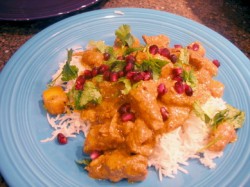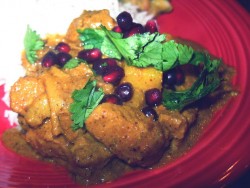Keeping and Breaking With Tradition: Pork Vindaloo with Coconut and Mango
Vindaloo, which is well-known as the “hottest” of curries available in most American and British Indian restaurants, is not just about tongue-searing heat. The name, which cames from the Portuguese “Vinha d’Alho”, which translates to “with wine and garlic,” does not have anything to do with potatoes (though they are a common ingredient in most US and UK curry establishments, nor chiles.
It is a dish that dates back to the colonial period, which Portuguese spice merchants took over the ports of Goa, and established a tradition of Christianity and pork eating, a rarity in the predominately Hindu and Muslim Indian subcontinent. The pork of vindaloo was originally cooked with plenty of garlic and wine or wine vinegar; however, in the hands of Indian cooks, it was improved greatly with the addition of mustard seeds, ginger, and the newly arrived and enthusiastically adopted New World chiles. It is a fiery dish; mustard, garlic, ginger, chile and onions all contain differing levels of heat and pungency, but I think that the idea of eating it hotter and hotter rather misses the point of the glorious tapestry of flavors that a well-made vindaloo will send dancing across a diner’s tongue.
I have eaten vindaloo in many restaurants, though never the traditional pork version. I guess it is because I first learned my Indian cooking and palate from a Muslim family, but I always thought that pork curry sounded somewhat odd and wrong. So, I always ate lamb or chicken versions, both of which are quite flavorful indeed.
I started cooking my own chicken version of it years ago, patterning it after the way they made it at Akbar Restaurant in Columbia, Maryland, which is one of the two best Indian restaurants I have had the pleasure of eating in here in the states. The addition of mango at the end of the cooking process was my own innovation; I have never seen any other recipes using the lush fruit in vindaloo. I think that is a shame, because the sweet, cooling fruit is the perfect counterpoint to the mustard and chile-rich curry sauce with its browned onions and slivers of ginger.
The other night, when I was thwarted in my attempt to buy fresh local chicken, but I had found mangoes on sale, I decided to use the locally produced pork I had on hand to make my own mark on the original dish. Not wanting to cook it exactly the same way I cook the chicken dish, I decided to play with the masala mixture, and instead of using vinegar in the marinade, I opted for the more subtle, fruity souring agent of tamarind, in the form of tamarind concentrate. (There are a few recipes, most notably those by Julie Sahni, which specify the use of tamarind rather than the more traditional vinegar.)
Finally, I remembered reading one recipe out of all of my Indian cookbooks (I have over thirty-five of them at last count) which specified the optional use of coconut milk in the cooking of pork vindaloo. This would be the recipe in Madhur Jaffrey’s book, Quick and Easy Indian Cooking, which is my bible when it comes to using a pressure cooker to make curries that taste like they have simmered all day, even if I don’t have hours to hang out in the kitchen. I don’t really think that the use of coconut milk is traditional in the making of this Goanese dish; none of the other cookbooks in my collection specify its use. However, when I tried it out with the pork, the modified masala and mangoes, it really made a spectacular curry that had all of the spice and aroma of vindaloo along with the sweet richness of coconut milk and the zing of mango.
It was, in a word, delicious.
Now, I have to work on a lamb version of this dish for when my Muslim friends come to visit.
Pork Vindaloo with Coconut and Mango
Ingredients:
2 tablespoons mustard seeds
1 tablespoon cumin seeds
1 black cardamom pod
1 teaspoon coriander seeds
1 teaspoon fenugreek seeds
1/2 teaspoon black peppercorns
3/4″ piece cinnamon stick
2 teaspoons ground turmeric
1 teaspoon ground cayenne pepper (optional)
2 teaspoon ground sweet paprika
2 cloves garlic, sliced
1/2″ cube ginger, sliced
3 tablespoons tamarind concentrate
1 1/2 pounds lean pork loin, cut into 1″ cubes
3 tablespoons canola, peanut or mustard oil
1 large onion, cut into paper-thin slices
2″ cube ginger, cut into thin jullienne strips
2- 5 fresh cayenne or Pakistani chiles, cut into thin slices on the diagonal (adjust heat level to your preference)
5 cloves garlic, cut into thin slices
1 cup canned coconut milk
1/2 cup water
tamarind concentrate to taste (I used about two more tablespoons)
salt to taste
1 cup roughly chopped cilantro
2 fresh ripe mangoes, peeled and diced
pomegranate seeds for garnish (optional)
Method:
Put first eleven ingredients into a food grinder like the Sumeet (or, use a coffee grinder for the dry spices and then put them into a blender with the wet ingredients) and process into a thick paste. Toss the cubes of pork with this paste and cover and marinate in the refrigerator for at least two hours, up to overnight.
When you are ready to cook the curry, heat the oil in the bottom of a pressure cooker or a large, heavy bottomed dutch oven. Add the onion and cook, stirring constantly, until it turns a medium golden brown. Add ginger and fresh chile slices and continue stirring until the onion is dark reddish brown and very fragrant. Add garlic and marinated pork and cook, stirring, until the meat is browned on all sides. Add coconut milk and water, and scrape up any browned bits that adhere to the bottom of the pot.
If using a pressure cooker, bring liquid to a boil, lock down lid and set at high pressure. Cook at high pressure for twenty minutes, then remove from heat and allow the cooker to reduce pressure to normal naturally as it cools–a process which will take about fifteen minutes. (If you are not using a pressure cooker, add more water and simmer, covered until pork is tender–about two hours–adding water as needed to keep curry from drying out and sticking on the bottom.)
When pressure is normal, open pressure cooker and bring vindaloo to a boil again. Cook, stirring, until the sauce reduces and thickens somewhat–when it coats the back of a spoon, it is ready.
Add tamarind concentrate and salt to taste, and stir in cilantro and ripe mangoes. Serve with steamed basmati rice. If you have them, sprinkle each serving with pomegranate seeds for a garnish.
3 Comments
RSS feed for comments on this post.
Sorry, the comment form is closed at this time.
Powered by WordPress. Graphics by Zak Kramer.
Design update by Daniel Trout.
Entries and comments feeds.





I have a filthy cold, but the thought of all the spices with the coconut and mango is making my mouth water. I’m going to have to try this out when I feel better. Vindaloo is my favorite.
Comment by Honey — January 10, 2007 #
Looks good Barbara. I’ve never tried pork either as it just seemed “wrong”, although I know it is traditional.
I think the combination of chillies, ginger and mustard heats the entire throat/mouth, which makes it a strong dish. Something like mustard hits the tongue first, ginger the mouth and chilli the throat…
Sadly in the UK restaurants all too often just crank up the chilli for the late-night, drunken crowd.
Comment by Steph in the UK — January 11, 2007 #
Honey–Vindaloo just might help beat that cold. Chile, mustard, ginger, garlic, turmeric and I believe, cumin, all have antibiotic properties. They also help clear the sinuses–I should know–I am the bad sinus queen, but since I have started cooking and eating with these ingredients almost daily, I haven’t had a sinus infection in years.
I think that my continued good health has to do with my penchant for spicy Chinese and Indian food.
Steph–I agree with you. Chiles, ginger and mustard are all heat producers–but the chemical constituents that make them “hot” are all different and affect the palate and tongue differently. So, in effect, you get a culinary cluster bomb with vindaloo–each spice “going off” at different rates in different parts of the mouth, and throat.
That is what makes it fun, I reckon!
Comment by Barbara — January 12, 2007 #